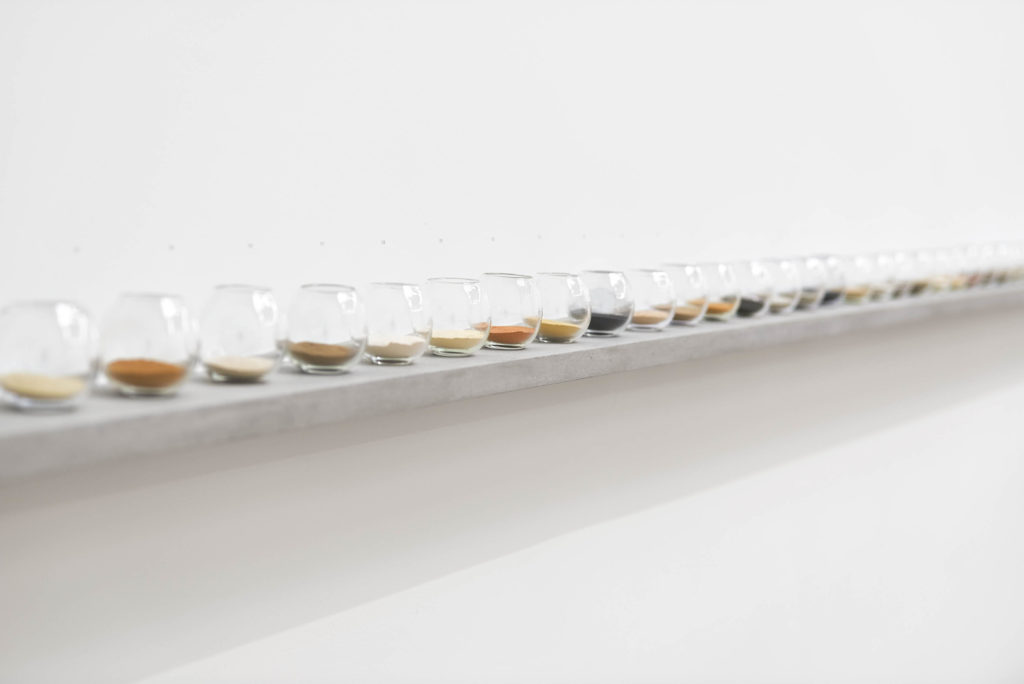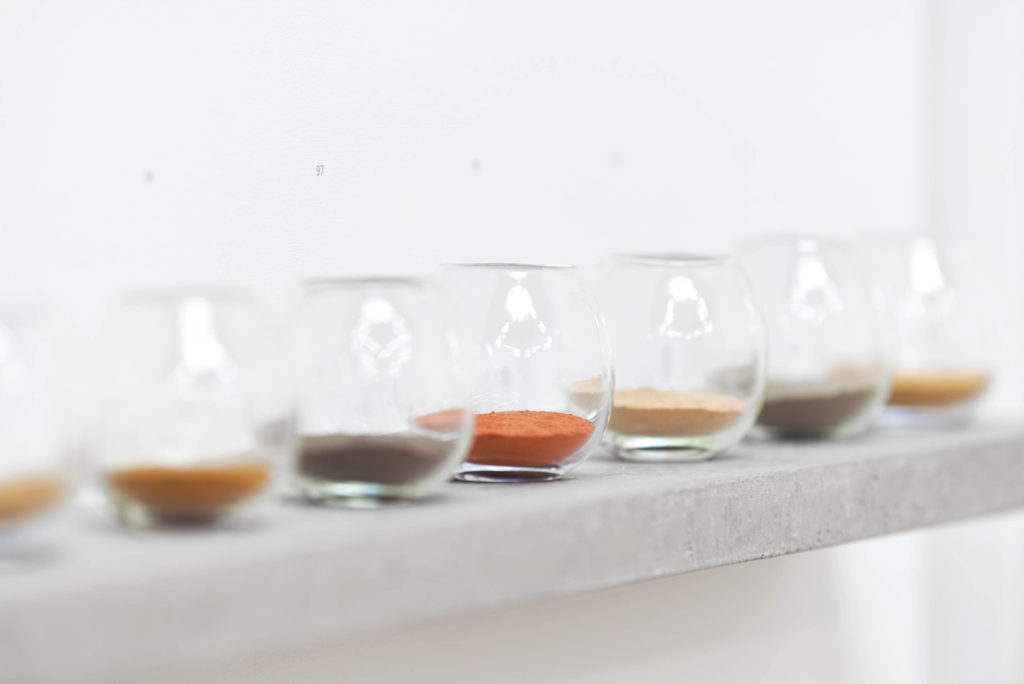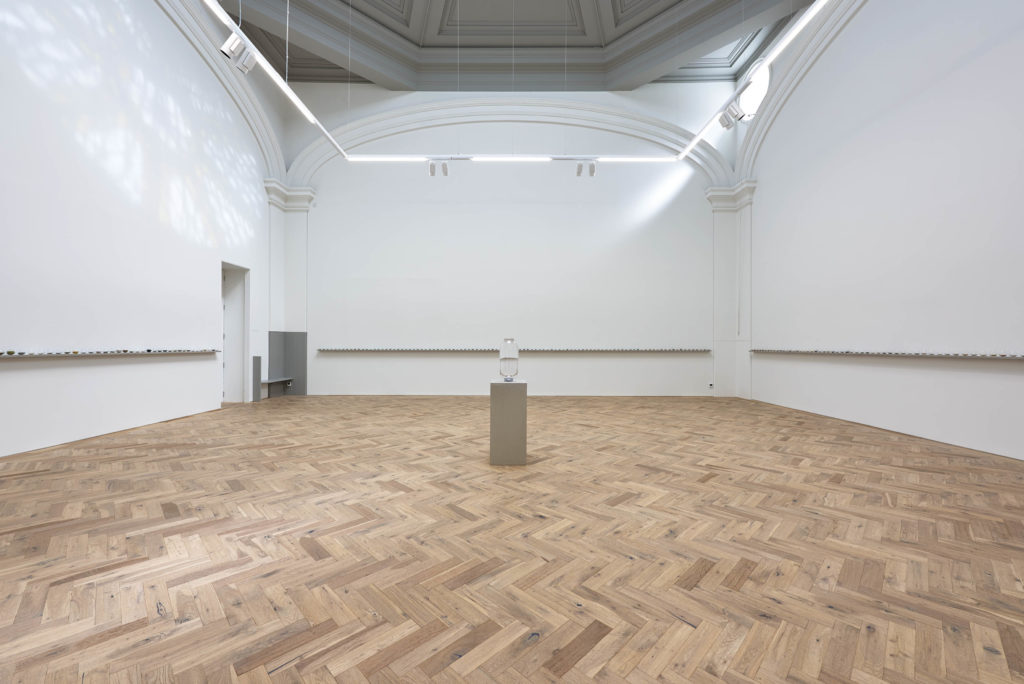With her artwork ‘Requiem’, Katie Paterson folds place and time together, creating a room which manages to hold all of Earth’s history — and it is phenomenal, concludes Anna Fleming.

Courtesy of the Artist and Ingleby, Edinburgh. Photograph: John McKenzie.
From the cobbles on a tenamented street in Edinburgh, I press the buzzer and am let into a gallery where, taking a moment to adjust, I stop and sit, letting myself acclimatise to the room. There is a quiet aura in this space — a glowing emptiness — hovering somewhere between the sensation of being in an art gallery, a church or a morgue. A grandfather clock ticks from the hallway. Daylight floods in from windows overhead. The longer I sit, slowly taking it all in, the more it feels like the room is breathing.
Several hundred glass vials line up on a shelf running around the room. They are beautiful and irregular, shaped like little globes, each catching and reflecting the light, some thicker, some thinner, some slightly larger, others smaller — the subtle ripples and inconsistencies betraying the craftwork of a human hand. Half are empty. The other half contain little mounds of coloured powder: ashes or dust, perhaps. In the middle of the room a glass urn stands on a plinth. Inside the urn, many different coloured powders come together, poured in by one-by-one, layering up like the sands of time to form the centrepiece of Katie Paterson’s artwork Requiem.
Passing around the room, I pause where the empty vials still carry traces of material. Black dust clings to some of the glasses. Others hold sandy-yellow traces, or specks of grey, orange, brown and gold essence. What were they? Discreet grey numbers painted on the wall provide a cue and I turn from the glass to the accompanying sheets of paper.
Another world unfolds, meticulously assembled by Jan Zalasiewicz, a geologist and Professor of Paleobiology. Leafing through the pages, I discover that each vial is named, dated and given an explanatory prose paragraph. The blackened glasses contained carbon. Vial 91 held Carboniferous coal from Lancashire. 121 carried fossil tree charcoal from forest fires that took place 215 million years ago. The sandy-yellow dust of 172 is from a 70 million year old crocodile skull bone. The gold dust is not gold at all: it is the ground up remains of a sea urchin that lived in Madagascar some 100 million years ago.

Courtesy of the Artist and Ingleby, Edinburgh. Photograph: John McKenzie.
From vial 197 onwards, each glass contains little heaps of fine powder yet to be added to the urn. Many are brown, some khaki, with a few greys and blacks interspersed. A striking rich colour is 40,000 year old red ochre pigment from Australia – an iron oxide used in the art of indigenous Australian people and the Lascaux cave painters. The first vial held dust from a meteorite containing presolar grains, dating back some 4.6 billion years. The last one contains blood samples from a Polynesian snail that was reborn after extinction. In this room, all Earth time is present. It is a strange feeling.
Deep time is notoriously hard to handle. In another sandstone building not so far from here, I once attended a series of geology classes. In those lessons, listening closely, I took notes, studied diagrams and worked at the alien language, desperate to grasp our planet’s story. But trying to comprehend those seismic changes and time frames was painful and I left each class with a violent headache. Here, with support from the European Space Agency, Danish Geological Survey, Washington DC and the British Antarctic Survey, Paterson manages to hold all of Earth history — its many epochs, extinctions and transformations — together in a way that is neat and oddly calming. She has folded place and time together.
The clinical artistry of Requiem opens a space to reflect and absorb. Indeed, as I lean in over the open tops of the glass vials for a closer look, I realise I am quite literally breathing in fragments of deep time. (This becomes more alarming when I approach the synthetic chemicals of the twentieth century.) Like Daisy Hildyard’s novel Emergency, this artwork dissolves boundaries between time, matter and beings. And like that novel, there is a twist. Within all of the somnolent fluidity of Paterson’s deep-time lament, there lies a razor sharp point.
Vial 312 holds trinitite from Trinity test site in New Mexico. This is where the first atomic bomb was detonated in 1945. ‘In a circle more than half a kilometre in diameter,’ the papers explain, ‘the desert sand was flash-melted into a pale green, slightly radioactive glass that was given the name trinitite: a new-born and sinister cousin, one might say, of natural volcanic obsidian.’ This moment, singled out by Requiem, is held up as the point when we entered a new geological age: the Anthropocene; the period when human activity became the dominant influence on climate and environment.
Around this transition, the dust changes colour. One vial holds a strange baby pink powder and another is baby blue: these are Pepto-Bismol and fertiliser; some of the hundreds of thousands of synthetic compounds which have made Earth one of the most chemically diverse planets in the cosmos. On the shelf before me, a new geological reality is laid bare. It is phenomenal; appealing and uncanny.

Courtesy of the Artist and Ingleby, Edinburgh. Photograph: John McKenzie.
In the peculiar archive of Requiem, each glass contains worlds of earthly experience reduced down to essences that are poured away, one-by-one, into the urn at the centre. Like prayers or poems, each sample, from coal to fossil to chemical weighs exactly 21 grams: the weight of a human soul. At the invitation of the gallery assistant I carry vial 197 (fossilized camel brain) to the urn and pour it in. Through this little ceremony, a threshold is crossed. I become part of the artwork — complicit — feeling at once a world of sorrow and a strange lightness. From the artwork dreamed out of a basement in Berlin, a warning sounds loud and clear. Earth to Earth. Ashes to ashes. Dust to dust. The moment is grave. Time is running out.
*
Anna visited ‘Requiem’ as part of a wider exhibition, also titled ‘Requiem’, at Ingleby Gallery, Edinburgh, where it ran from 9 April – 11 June 2022.
Another Katie Paterson artwork, titled ‘The Moment’, is available to view at Durham Cathedral until 11 September, as part of the National Glass Centre’s Glass Exchange. More information here.
Anna Fleming’s debut book ‘Time on Rock’, a previous Caught by the River Book of the Month, has just been longlisted for the Wainwright Prize. Anna joins our lineup for this year’s Camp Good Life, where she will read from and discuss the book, and climbing more generally, with Helen Mort.